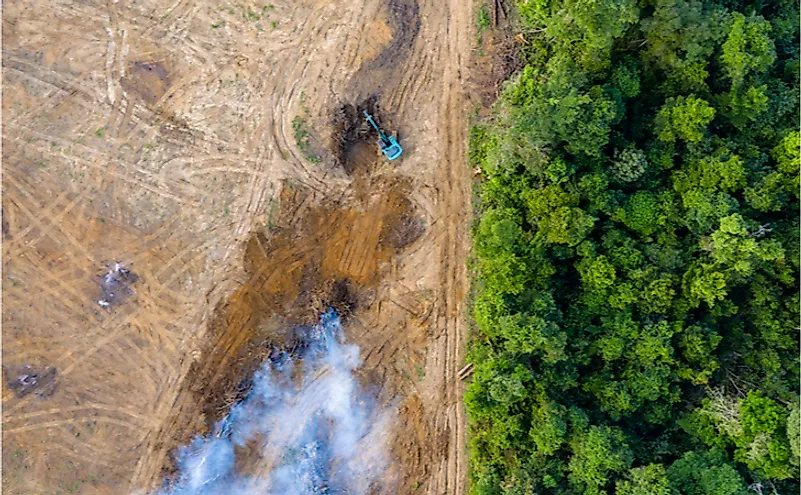What Would Happen If We Lost The Amazon Rainforest?

The Amazon rainforest, a massive stretch of dense rainforest covering parts of several South American countries, is home to the greatest biodiversity on Earth. It supports the lives of millions of South Americans who depend on the forest products directly or indirectly for their livelihood. The economies of many of the Amazon countries are driven by the rainforest. Brazil shares around 60% of this forest and the rest is divided between Bolivia, Colombia, Peru, Ecuador, French Guiana, Guyana, and Venezuela.
In recent decades, there have been growing concerns about the health of the Amazon rainforest. Environmentalists claim that rampant deforestation in the region is decreasing the forest cover at a rapid pace. They warn that the effects of damage to the Amazon rainforest would be severe and widespread. So, what are these effects? What will happen if the Amazon rainforest ceases to exist?
Climate Change Would Speed Up
The Amazon rainforest is often nicknamed "the lungs of the Earth." The millions of trees growing here absorb vast amounts of carbon dioxide, a major greenhouse gas whose increasing concentrations contribute to global warming. With deforestation in the Amazon, the ability of the forest to act as a carbon sink will diminish increasing the concentrations of carbon dioxide in the environment. Thus, climate change would occur at a faster rate and the adverse effects of such change would be felt globally.
More Intense Fires Will Engulf Life In The Amazon Countries
Brazil's largest city, Sao Paulo, experienced over an hour of darkness in daytime in August 2019 when smoke from fires burning in the Amazon 2,700 km away drifted to the city with the help of strong winds. Such incidents are predicted to increase in the future due to larger and more numerous fires triggered by deforestation. As more land will be cleared to make way for human activities, the stubbles of trees and other vegetation in the cleared areas will serve as fuel for wildfires. Such fires will grow to unstoppable infernos and engulf large parts of the primitive rainforest. Smoke and other particulates arising from such fires will pollute the air, water, and soil across large distances creating an environmental disaster of epic proportions. The greenhouse gases released from such fires will also intensify climate change leading to extreme weather conditions.
Catastrophic Floods Would Be More Frequent
Data shows that extreme floods in the Amazon basin have become more frequent in the last two to three decades. In the first half of the 20th century, severe floods defined by water levels exceeding 29 m occurred roughly every 20 years. Now, such floods occur about every four years. According to scientists, the rise in the number and severity of floods are linked to Walker circulation, ocean-influenced meteorological phenomena that are caused by climate change. Although overall rainfall might decrease, sporadic events of excessive rainfall might increase. The absence of the rainforest would mean that there is less tree cover to absorb surplus water. Catastrophic floods would then be inevitable.
Unpredictable Rainfall Patterns And Droughts
Scientists have shown that rainforests influence local and global climates in a major way. The largest rainforest, the Amazon, does this more than any other ecosystem in the world. Plants release water vapor into the atmosphere through evapotranspiration. This water significantly contributes to rainfall. Deforestation will thus decrease rainfall and trigger droughts. The latter, in turn, will lead to fires, and more deforestation. A vicious loop would form that would finally harm every life form in the region including humans.
Poverty Will Grip The Amazon Countries
Millions of people depend on the Amazon rainforest for their daily source of income. With the forests gone, their livelihood will also be lost. The forest regulates the rainfall patterns of the Amazon basin that is necessary for crop cultivation. Numerous rainforest products are the source of food, firewood, raw materials for handicraft, medicines, etc. The indigenous communities including many primitive tribes are completely dependent on the rainforest. The Amazon rainforest is also one of the biggest attractions for tourists visiting the Amazon countries. The loss of these forests would translate to a major economic setback for these countries that would push their people into abject poverty.
Loss Of Hope For Cures Of Human Diseases
Nature holds many secrets that are still undiscovered by humans. The Amazon rainforest has vast tracts of primitive forest that are yet to be touched by humans. Given the incredible biodiversity of the region, it would not be surprising if cures for many lethal human diseases remain hidden in its dark depths. For millennia, humans have used venoms and toxins, plant extracts, and microbiota found in forests to develop cures for various diseases. For example, cinchona trees native to the Amazonian slopes of the Andes have been used to develop the anti-malarial drug quinine. Hopes for the future development of such drugs including cures for cancer will be lost if the Amazon rainforest loses its biodiversity.
Species Will Be Lost Forever
The Amazon hosts the greatest biodiversity on planet Earth. An average of one new species is discovered here every day. With the destruction of the Amazon, Earth will lose this incredible biodiversity. Many species will vanish before we even come to know of them. Some of them might hold the secrets to miraculous cures. Since every species in an ecosystem is dependent on the other through the food web, loss of one species will lead to the death of the others. Humans who are also dependent on such species both directly and indirectly will suffer the disastrous consequences of biodiversity loss.











